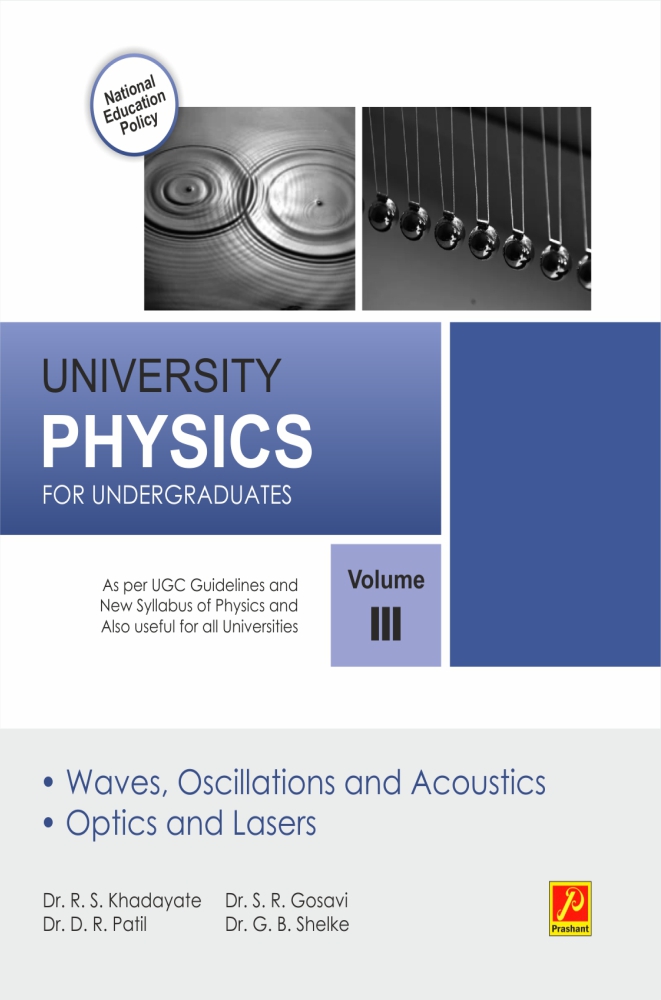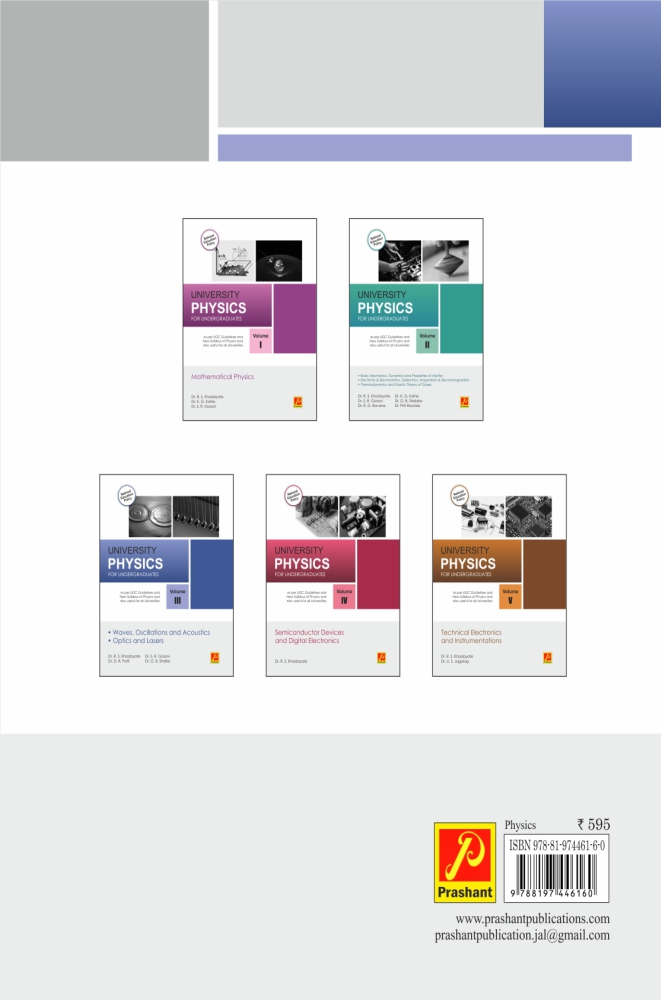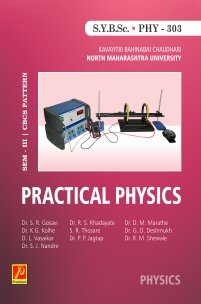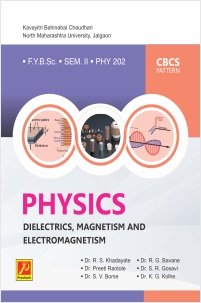University Physics for Undergraduates
(Volume III)
Authors:
ISBN:
₹595.00
- DESCRIPTION
- INDEX
Physics is the fundamental science that seeks to understand the natural laws governing the universe. Its principles form the basis for countless technological advancements and scientific inquiries that shape our world. This reference book aims to serve as a comprehensive guide for students, educators, and professionals who seek to deepen their understanding of this dynamic field.
We are very glad to present this book “University Physics for Undergraduates (Volume-III)”. Our objective in creating this book is to offer a detailed and systematic knowledge related to topics Waves, Oscillations and Acoustics, Optics and LASERs. This book is written by keeping in mind the curriculum prescribed by UGC.
To develop interest of learners, diagrams and solved examples are given in each chapter. At the end of each chapter, multiple choice questions, short answer questions and long answer questions are provided. The book is written in simple and lucid language.
This book is the result of contributions from numerous experts in various subfields of physics, whose insights and expertise have enriched its content. We extend our gratitude to these individuals for their dedication and hard work.
1. Compositions of Two SHM.s
1.1 Introduction, 1.2 Composition of two S.H.M.s of equal frequencies along same line of vibration (analytical method), 1.3 Composition of two S.H.M.s of equal frequencies acting at right angles (analytical method), 1.4 Composition of two S.H.M.s right angles to each other (time period in the ratio 1:2),
1.5 Lissajous’ Figures, 1.6 Uses of Lissajous’ figures.
2. Waves Motion
2.1 Transverse waves on a string, 2.2 Traveling and standing waves on a string, 2.3 Normal modes of a string, 2.4 Plane Waves, 2.5 Spherical Waves, 2.6 Wave Intensity.
3. Damped Oscillations
3.1 Introduction 3.2 Undamped free oscillations 3.3 Damped Oscillations 3.4 Differential equation of a damped harmonic oscillator & it’s solution
3.5 Discussion of three different cases 3.6 Logarithmic decrement 3.7 Energy equation of damped harmonic oscillator 3.8 Power dissipation and Quality factor 3.9 Application to Series L-C-R circuit (Damped S.H.M. in an electrical circuit).
4. Forced Oscillations
4.1 Idea of Forced Oscillations, 4.2 Comparison between Damped and Forced Oscillations, 4.3 Resonance, 4.4 Differential Equation of Forced Oscillations and its Solution, 4.5 Amplitude Resonance, 4.6 Sharpness of Resonance and Half Width, 4.7 Velocity Resonance, 4.8 Energy in Forced Oscillations,
4.9 Band Width, 4.10 Quality factor (Q), 4.11 Forced oscillations in an electrical circuits (Application to Series L-C-R circuits).
5. Sound
5.1 Sound and its Characteristics, 5.2 Classification of Sound Frequencies,
5.3 Production of Ultrasonic Waves, 5.4 Mechanical Method, 5.5 Method using Piezo-electric effect, 5.6 Applications of Ultrasonic Waves, 5.7 Doppler Effect.
6. Geometrical Optics
6.1 Introduction, 6.2 Sign conventions used in optics, 6.3 A thin lens,
6.4 Expression for deviation produced by a single thin lens, 6.5 Expression for equivalent focal length of two thin lenses separated by a distance ‘x’, 6.6 Power of lens, 6.7 Aberrations due to lenses
7. Interference
7.1 Review of some concepts, 7.2 Principle of superposition of two waves,
7.3 Concept of interference of light, 7.4 Necessary conditions to observe steady interference pattern, 7.5 The intensity distribution in the interference pattern, 7.6 Expression for fringe width (band width), 7.7 Techniques of Obtaining Interference, 7.8 Young’s Double slit experiment, 7.9 Fresenel Biprism,
7.10 Lloyd’s Single mirror, 7.11 Stoke’s treatment, 7.12 Interference in thin films, 7.13 Interference due to reflected light, 7.14 Haidinger Fringes, 7.15 Fringes of equal thickness, 7.16 Interference in thin wedge shaped film: (Interference due to reflected system in wedge shaped film), 7.17 Newton’s Ring
8. Diffraction
8.1 Definition and concept of diffraction, 8.2 Fresnel’s Diffraction, 8.3 Fraunhofer’s Diffraction, 8.4 Diffraction Grating, 8.5 Distinction between Interference and Diffraction, 8.6 Distinction between Fraunhofer diffraction and Fresnel diffraction
9. Polarization
9.1 Introduction, 9.2 Experiment to determine transverse nature of light, 9.3 Polarization, 9.4 Comparison of unpolarized and polarized light, 9.5 Types of polarization, 9.6 Production and detection of circularly and elliptically polarized light, 9.7 Basic phenomena of Polarization, 9.8 Polarization by reflection, 9.9 Brewster’s law, 9.10 Polarization by refraction, 9.11 Polarization by Scattering, 9.12 Polarization by selective absorption, 9.13 Construction of Polaroid, 9.14 Polarization by double refraction, 9.15 Double refracting crystals, 9.16 Polarizer and analyzer, 9.17 Production of linearly polarized light, 9.18 Detection of linearly polarized light, 9.19 Malus’ Law, 9.20 Huygens explanation for normal incidence, 9.21 Positive and negative crystals, 9.22 Nicol prism, 9.23 Quarter and Half wave plates, 9.24 Optical Activity,
9.25 Optical Rotation, 9.26 Specific Rotation, 9.27 Polarimeter or Sacherimeter
10. Lasers
10.1 Introduction, 10.2 Characteristics of LASER, 10.3 Basic steps required to form a LASER, 10.4 LASER pumping, 10.5 Basic Components of LASER, 10.6 Types of LASER, 10.7 Applications of LASER.
11. Holography and its Application
11.1 Introduction 11.2 Principle of Holography 11.3 Concept of monochromatic source 11.4 Concept of coherent source 11.5 Basic idea of hologram 11.6 Recording (construction) of the Hologram 11.7 Reconstruction of the image (viewing the object) 11.8 Types of hologram (list only) 11.9 Applications of holography 11.10 Photography Vs Holography
12. Fiber Optics
12.1 Introduction 12.2 Fiber Optic Communication System 12.3 Construction of Optical fiber 12.4 Principal of Operation of Optical Fiber 12.5 Acceptance angle and Numerical Aperture 12.6 Attenuation in Fiber 12.7 Preparation of Optical Fiber 12.8 Optical Fiber Materials 12.9 Types of Optical Fiber 12.10 Difference between Step Index and Graded Index Fiber 12.11 Losses in Optical Fiber 12.12 Optical Fiber Cables 12.13 Applications of Fiber Optics 12.14 Detail discussions on fiber optic Applications.









